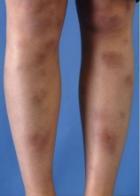Factsheet
What is yersiniosis?
Yersiniosis is a form of gastroenteritis caused by the bacteria Yersinia enterocolitica or Yersinia pseudotuberculosis. Many animals can act as hosts for these bacteria, but pigs are the most common reservoir. Yersiniosis is a notifiable disease in Ireland.
How common is yersiniosis?
While Yersiniosis is the third most reported gastrointestinal infection in the EU/EEA after campylobacter and salmonellosis, it is not common in Ireland. In 2022, there were only 17 notifications in Ireland.
What are the symptoms of yersiniosis?
Symptoms of Yersinosis most often develop 3-7 days after infection. The most common symptoms are:
- Fever
- Gastrointestinal problems – diarrhoea and pain in the lower right part of the abdomen (this can often be confused with appendicitis)
Additional symptoms may include:
- Sore throat
- Erythema nodosum – presents as tender red patches and bumps that are often found on the shins
Reactive arthritis is a complication of yersiniosis, and symptoms of this include joint pain and stiffness, conjunctivitis, heel pain, lower back pain that tends to be worse at night, as well as urinary problems such as increased frequency and discomfort when urinating.
A life-threatening condition called sepsis can also occur when the infection enters the bloodstream.
Erythema nodosum

How is yersiniosis spread?
Yersiniosis is generally spread by handling or eating raw/undercooked meat, especially pork, as well as from coming in contact with contaminated faeces. It can also be spread from other animals too, such as rodents, cows, sheep, rabbits, and horses. Occasionally, there can be spread from pets, food, or drink. These bacteria can multiply at low temperatures of down to 40C (the temperature found in a domestic fridge). Very rarely, a person gets yersiniosis by receiving blood through a transfusion from an infected person.
Who is at risk of yersiniosis?
Anyone who comes in contact with contaminated meat is at risk, although children and adolescents are most often affected. People who prepare chitlins (a food made from pig intestines) are also more likely to get and spread the infection.
How is yersiniosis diagnosed?
Diagnosis is based on a physical examination and a stool sample. The sample is sent to a lab to test for the yersinia bacteria.
What is the treatment for yersiniosis?
Often yersiniosis gets better without treatment as the body naturally gets rid of and then develops immunity to yersinia. Simple measures such as adequate hydration may be all that is required. In severe yersiniosis, antibiotics may be prescribed.
Can yersiniosis be prevented?
The best ways to protect yourself again yersiniosis is to ensure that you wash your hands regularly and take care when preparing food. Avoid unpasteurised products which haven’t been through a process to kill bacteria. In addition, all meat should be thoroughly cooked until juices run clear. A food thermometer can be used to make sure it is cooked enough. It is important to remember that a person is contagious while they have diarrhoea and up to 3 months after the diarrhoea has stopped. Similarly, care should be taken when disposing of animal faeces.
Last Updated: 20 October 2023


